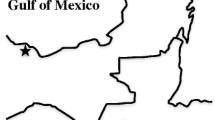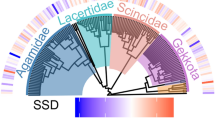Abstract
The longhorn beetle Morimus asper exhibits the typical sexual dimorphism of cerambycid beetles: males have longer antennae than females and the antennal length also varies greatly among males of the same population. This study explores the sexual dimorphism in M. asper and the scaling relationship between antennal length and body size in males. Our aim was to assess the allometric pattern of these two traits and their potential effects on individual eco-ethological features. Sexual dimorphism was observed in antennal length and in other morphological traits: males showed longer pronota and females larger and longer elytra, suggesting that males allocate more resources to the anterior body traits, while in females more resources are invested in the development of post-prothoracic body traits. The allometric relationship between antennal length and elytra length of males was best described by a segmented regression, which identified a switch point dividing the male population into two different groups. The analysis of covariance showed that smaller males (with elytra length below the switch point) exhibit a positive allometry, while larger males (above the switch point) showed isometric scaling relationship. Our findings showed that morphometric traits were correlated with aspects of male behaviour and ecology: larger males were more frequently found mating, probably because they have an advantage in defending mates and in winning fights against other males.




Similar content being viewed by others
References
Amstrup SC, McDonald TL, Manly BFJ (2005) Handbook of capture-recapture analysis. Princeton University Press, Princeton
Bertin A, Cezilly F (2003) Sexual selection, antennae length and the mating advantage of large males in Asellus aquaticus. J Evol Biol 16:698–707
Bonduriansky R (2007) Sexual selection and allometry: a critical reappraisal of the evidence and ideas. Evolution 61:838–849
Campanaro A, Bardiani M, Spada L, Carnevali L, Montalto F, Antonini G, Mason F, Audisio P (2011) Linee guida per il monitoraggio e la conservazione dell’entomofauna saproxylica/guidelines for monitoring and conservation of saproxylic insects. Quaderni Conservazione Habitat, 6. Cierre Grafica, Verona
Cardè RT, Bell WJ (1995) Chemical ecology in insects II. Chapman and Hall, London
Cherepanov AI (1988) Cerambycidae of Northern Asia, vol 1. Amerind, New Delhi
Cook JM, Bean D (2006) Cryptic male dimorphism and fighting in a fig wasp. Anim Behav 71:1095–1101
Cotton S, Fowler K, Pomiankowski A (2004) Condition dependence of sexual ornament size and variation in the stalk-eyed fly Cyrtodiopsis dalmanni (Diptera: Diopsidae). Evolution 58:1038–1046
Dajoz R (1976) Etude morphologique et biometrique des Morimus (Col., Cerambycidae) de la faune europeenne. Entomologiste 326:212–231
Darwin CR (1874) The descent of man and selection in relation to sex. Hurst, New York
Davies RB (1987) Hypothesis testing when a nuisance parameter is present only under the alternative. Biometrika 74:33–43
Development Core Team R (2010) R: a language and environment for statistical computing. R Foundation for Statistical Computing, Vienna
Eberhard WG (1982) Beetle horn dimorphism, making the best of a bad lot. Am Nat 119:420–426
Eberhard WG, Gutierrez EE (1991) Male dimorphisms in beetles and earwigs and the question of developmental constraints. Evolution 45:18–28
Emlen DJ (2001) Costs and the diversification of exaggerated animal structures. Science 291:1534–1536
Emlen DJ (2014) Animal weapons: the evolution of battle. Henry Holt and Company, New York
Emlen DJ, Allen CE (2004) Genotype to phenotype: physiological control of trait size and scaling in insects. Integr Comp Biol 43:617–634
Emlen DJ, Nijhout HF (2000) The development and evolution of exaggerated morphologies in insect. Ann Rev Entomol 45:661–780
Emlen DJ, Nijhout HF (2001) Hormonal control of male horn length dimorphism in the horned beetle Onthophagus taurus (Coleoptera: Scarabaeidae): a second critical period of sensitivity to juvenile hormone. J Insect Physiol 47:1045–1054
Entling W, Schmidt-Entling MH, Bacher S, Brandl R, Nentwig W (2010) Body size e climate relationships of European spiders. J Biogeogr 37:477–485
Fattorini S, Lo Monaco R, Di Giulio A, Ulrich W (2013) Latitudinal trends in body length distributions of European darkling beetles (Tenebrionidae). Acta Oecol 53:88–94
Gotoh H, Miyakawa H, Ishikawa A, Ishikawa Y, Sugime Y, Emlen DJ, Lavine LC, Miura T (2014) Developmental link between sex and nutrition; doublesex regulates sex-specific mandible growth via juvenile hormone signaling in stag beetles. PLoS Genet 10:e1004098. doi:10.1371/journal.pgen.1004098
Gould SJ (1966) Allometry and size in ontogeny and phylogeny. Biol Rev 41:587–640
Goyens J, Dirckx J, Aerts P (2015) Costly sexual dimorphism in Cyclommatus metallifer stag beetles. Funct Ecol 29:35–43
Green AJ (1992) Positive allometry is likely with mate choice, competitive display and other functions. Anim Behav 43:170–172
Hammer O, Harper D, Ryan P (2001) PAST: paleontological statistics software package for education and data analysis. Paleontol Electron 4:1–9
Hanks LM (1999) Influence of the larval host plant on reproductive strategies of cerambycid beetles. Annu Rev Entomol 44:483–505
Hanks LM, Millar JG, Paine TD (1996a) Body size influences mating success of the Eucalyptus Longhorned Borer (Coleoptera: Cerambycidae). J Insect Behav 9:369–382
Hanks LM, Millar JG, Paine TD (1996b) Mating behavior of the Eucalyptus Longhorned Borer (Coleoptera: Cerambycidae) and the adaptive significance of long “Horns”. J Insect Behav 9:383–393
Hanley RS (2001) Mandibular allometry and male dimorphism in a group of obligately mycophagous beetles (Insecta: Coleoptera: Staphylinidae: Oxyporinae). Biol J Linn Soc 72:451–459
Hardersen S, Macagno ALM, Sacchi R, Toni I (2011) Seasonal constraints on the mandible allometry of Lucanus cervus (Coleoptera: Lucanidae). Eur J Entomol 108:461–468
Holwell GI, Barry KL, Herberstein ME (2007) Mate location, antennal morphology, and ecology in two praying mantids (Insecta: Mantodea). Biol J Linnean Soc 91:307–313
Huxley JS (1932) Problems of relative growth. Methuen, London
Iguchi Y (2013) Male mandible trimorphism in the stag beetle Dorcus rectus (Coleoptera: Lucanidae). Eur J Entomol 110:159–163
Jennions MD, Møller AP, Petrie M (2001) Sexually selected traits and adult survival: a meta-analysis. Quart Rev Biol 76:3–36
Johnstone RA (1995) Sexual selection, honest advertisement and the handicap principle: reviewing the evidence. Biol Rev 70:1–65
Kaiser A, Klok CJ, Socha J, Lee W, Quinlan MC, Harrison JF (2007) Increase in tracheal investment with beetle size supports hypothesis of oxygen limitation on insect gigantism. Proc Natl Acad Sci USA 104:13198–13203
Kawano K (1997) Cost of evolving exaggerated mandibles in stag beetles (Coleoptera: Lucanidae). Ann Entom Soc Am 90:453–461
Kawano K (2006) Sexual dimorphism and the making of oversized male character in beetles (Coleoptera). Ann Entom Soc Am 99:327–341
Knell RJ (2009) On the analysis of non-linear allometries. Ecol Entomol 34:1–11
Knell RJ, Simmons LW (2010) Mating tactics determine patterns of condition dependence in a dimorphic horned beetle. Proc R Soc Lond B 277:2347–2353
Knell RJ, Pomfret JC, Tomkins JL (2004) The limits of elaboration: curved allometries reveal the constraints on mandible size in stag beetles. Proc R Soc Lond B 271:523–528
Kodric-Brown A, Sibly RM, Brown JH (2006) The allometry of ornaments and weapons. Proc Natl Acad Sci USA 103:8733–8738
Kojima W, Lin CP (2017) It takes two to tango: functional roles, sexual selection and allometry of multiple male weapons in the flower beetle Dicronocephalus wallichii bourgoini. Biol J Linnean Soc 121:514–529. doi:10.1093/biolinnean/blx018
Kotiaho JS, Tomkins JL (2001) The discrimination of alternative male morphologies. Behav Ecol 12:553–557
Levinton J (1988) Genetics, paleontology and macroevolution. Cambridge University Press, Cambridge
Linsley EG (1959) Ecology of Cerambycidae. Ann Rev Entomol 4:99–138
Linsley EG (1961) The Cerambycidae of North America. I. Introduction. Univ Calif Publ Entomol 18:1–135
McCrary J (2008) Manipulation of the running variable in the regression discontinuity design: a density test. J Econom 142:698–714. doi:10.1016/j.jeconom.2007.05.005
McCullough EL, Ledger KJ, O’Brien DM, Emlen DJ (2015) Variation in the allometry of exaggerated rhinoceros beetle horns. Anim Behav 109:133–140
Moczek AP, Emlen DJ (2000) Male horn dimorphism in the scarab beetele Onthophagus taurus: do alternative reproductive favour alternative phenotypes? Anim Behav 59:459–466
Moczek AP, Nijhout HF (2004) Trade-offs during the development of primary and secondary sexual traits in a horned beetle. Am Nat 163:184–191
Moczek AP, Hunt J, Emlen DJ, Simmons LW (2002) Threshold evolution in exotic populations of a polyphenic beetle. Evol Ecol Res 4:587–601
Møller AP, Zamora Muñoz C (1997) Antennal asymmetry and sexual selection in a cerambycid beetle. Anim Behav 54:1509–1515
Myers SS, Buckley TR, Holwell GI (2015) Mate detection and seasonal variation in stick insect mating behaviour (Phamatodea: Clitarchus hookeri). Behaviour 152:1325–1348
Nijhout HF (1994) Insect hormones. University Press, Princeton
Nijhout HF, Wheeler DE (1996) Growth models of complex allometries in holometabolous insects. Am Nat 148:40–56
Painting C, Holwell G (2013) Exaggerated trait allometry, compensation and trade-offs in the New Zealand Giraffe Weevil (Lasiorhyncus barbicornis). PloS ONE 8:e82467
Painting CJ, Buckley TR, Holwell GI (2014) Weapon allometry varies with latitude in the New Zealand giraffe weevil. J Evol Biol 27:2864–2870
Petrie M (1988) Intraspecific variation in structures that display competitive ability: large animals invest relatively more. Anim Behav 36:1174–1179
Plaistow SJ, Tsuchida K, Tsubaki Y, Setsuda K (2005) The effect of a seasonal time constraint on development time, body size, condition, and morph determination in the horned beetle Allomyrina dichotoma L. (Coleoptera: Scarabaeidae). Ecol Entomol 30:692–699
Polak S (2012) Phenology and mating behaviour of Morimus funereus (Coleoptera, Cerambycidae). In: Jurc M (ed) Saproxylic beetles in Europe: monitoring, biology and conservation, vol 137. Slovenian Forestry Institute, Ljubljana, pp 43–52
Pomfret JC, Knell RJ (2006) Sexual selection and horn allometry in the dung beetle Euoniticellus intermedius. Anim Behav 71:567–576
Romero-Samper J, Bahillo P (1993) Algunas observaciones sobre la distribución y biología de Morimus asper (Sulzer, 1776) (Coleoptera: Cerambycidae) en la Península Ibérica. Boln Asoc Esp Ent 17:103–122
Romiti F, Tini M, Redolfi De Zan L, Chiari S, Zauli A, Carpaneto GM (2015) Exaggerated allometric structures in relation to demographic and ecological parameters in Lucanus cervus (Coleoptera: Lucanidae). J Morphol 276:1193–1204
Romiti F, Redolfi De Zan L, Piras P, Carpaneto GM (2016) Shape variation of mandible and head in Lucanus cervus (Coleoptera: Lucanidae): a comparison of morphometric approaches. Biol J Linnean Soc. doi:10.1093/biolinnean/blw001
Romiti F, De Zan LR, de Gasperis SR, Tini M, Scaccini D, Anaclerio M, Carpaneto GM (2017) Latitudinal cline in weapon allometry and phenology of the European stag beetle. Nat Conserv 19:57. doi:10.3897/natureconservation.19.12681
Rossi de Gasperis S, Passacantilli C, Redolfi De Zan L, Carpaneto GM (2016) Overwintering ability and habitat preference of Morimus asper: a two-year mark-recapture study with implications for conservation and forest management. J Insect Conserv 20:821–835. doi:10.1007/s10841-016-9913-7
Rowland JM, Emlen DJ (2009) Two thresholds, three male forms result in facultative male trimorphism in beetles. Science 323:773–776
Saikia K, Thakur NSA, Ao A, Gautam S (2012) Sexual dimorphism in Pseudonemorphus versteegi (Ritsema) (Coleoptera: Cerambycidae), Citrus Trunk Borer. Fla Entomol 95:625–629
Sama G (1988) Coleoptera, Cerambycidae. Catalogo Topografico e Sinonimico. Fauna d’Italia. XXXVI. Ed. Calderini, Bologna
Tazzyman SJ, Iwasa Y, Pomiankowski A (2014) The handicap process favors exaggerated, rather than reduced, sexual ornaments. Evolution 68:2534–2549
Wang Q, Zeng W (2004) Sexual selection and male aggression of Nadezhdiella cantori (Hope) (Coleoptera: Cerambycidae: Cerambycinae) in relation to body size. Environ Entomol 33:657–661
Williams CM (1980) Growth in insects. In: Locke M, Smith DS (eds) Insect biology in the future. Academic Press, New York, pp 369–382
Zeh DW, Zeh JA (1992) Sexual selection and sexual dimorphism in the harlequin beetle Acrocinus longimanus. Biotropica 24:86–96
Acknowledgements
The authors are grateful to Roberto Sacchi for his technical advice on statistical analysis, and to Chiara Passacantilli for her field support.
Author information
Authors and Affiliations
Corresponding author
Ethics declarations
The authors declare that they have no conflict of interest and no founding was received. All applicable international, national and/or institutional guidelines for the care and use of animals were followed.
Rights and permissions
About this article
Cite this article
Rossi de Gasperis, S., Redolfi De Zan, L., Romiti, F. et al. Sexual dimorphism and allometry of secondary sexual character in Morimus asper (Coleoptera: Cerambycidae). Zoomorphology 137, 119–130 (2018). https://doi.org/10.1007/s00435-017-0380-9
Received:
Revised:
Accepted:
Published:
Issue Date:
DOI: https://doi.org/10.1007/s00435-017-0380-9




